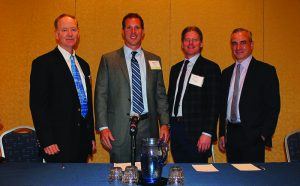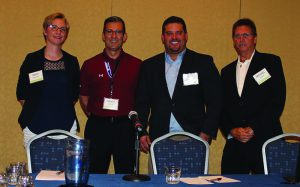 Shown (from left) are: Kenny Marshall, JL Marshall; Matthew Consigli, Consigli Construction; Chris Floyd, CE Floyd; and Joe Albanese, Commodore Builders.
Shown (from left) are: Kenny Marshall, JL Marshall; Matthew Consigli, Consigli Construction; Chris Floyd, CE Floyd; and Joe Albanese, Commodore Builders.Boston, MA Advances in technology such as drones, virtual reality and laser scanning are playing an increasingly large role in the construction business, but it is still the human factor – or more precisely, how the problem of the shortages in both skilled labor and professional talent will be addressed – that will determine the future of the industry in the years to come. What lies ahead for both man and machine were thoroughly examined by the expert panels assembled for the recent New England Real Estate Journal “Construction Trends of the Future” symposium held at the Boston Marriott Newton, as well as a look at how the construction boom is affecting the ability of contractors and owners to adequately insure their projects.
The first panel, moderated by Joe Albanese, founder & CEO of Commodore Builders and immediate past chair of AGC MA (Associated General Contractors of Mass.), featured Matthew Consigli, president of Consigli Construction; Christopher Floyd, president & CEO of C.E. Floyd Company, Inc.; and Kenny Marshall of J.L. Marshall & Sons, Inc. Area contractors are reporting difficulty in finding qualified workers to fill jobs, and Albanese set up the discussion by providing the historical context for the shortfall. During the recessionary period from 2008-2011, “there really was a flight from our industry at the mid-level and lower level – and I don’t think that we’ve recovered from that,” said Albanese.
As a result, there is currently an “overabundance” of apprentices and interns now in the industry, with a significant “gap in the middle” – journeyman, skilled trade labor, project managers – between the new blood and senior executives. One of the contributing factors is that workers in those mid-level positions are aging, and there just aren’t enough skilled people to take their place, he asserted. “When you look at the workers that are swinging from steel girders to beams, there’s a lot of grey hair there, and it’s really a young man’s game. And we need journeymen to fill those positions, not just warm bodies.”
 Shown (from left) are: Siggy Pfendler, Columbia Construction Co.; Randy Niederer, Cambridge Engineering; Ron Carlstrom, Real Big Media; and Michael Hoban, Hoban Communication.
Shown (from left) are: Siggy Pfendler, Columbia Construction Co.; Randy Niederer, Cambridge Engineering; Ron Carlstrom, Real Big Media; and Michael Hoban, Hoban Communication.Floyd said that his firm is seeing shortages “across the board, with both salaried professionals and craftsmen” but particularly in the areas of curtain wall (specialists), pipefitters and electricians, as well as tile setters and carpet installers. Consigli added that his firm is having difficulty filling the professional positions such as superintendents, “because it really takes the most time to develop a quality superintendent. It’s based on years of experience and exposure to systems, leading a team, being on the job site and understanding enough about the work to plan ahead.” Marshall, whose firm focuses primarily on concrete work, said his firm’s biggest labor challenge is finding estimators, and added that engineering students that once went into civil engineering are now pursuing biotech instead. He also re-iterated the assertion that, “It takes a long time to get skilled at what we do.”
In terms of solving the issue, the panel stressed the importance of referrals in pursuing talent, and Consigli said that his firm was investing in training and developing entry level staff to eventually become superintendents. Albanese said that AGC was working simultaneously on the workforce shortage as well as the diversity issue in the industry by encouraging employer groups to take the lead in developing a workforce solution by developing training programs that tap into the inner city’s unemployment problem.
The second panel shifted the focus to the labor-saving and enhancing technologies impacting the construction process. And while the building industry has traditionally been slow to adopt technological solutions, the group made a strong cases for taking advantage of the innovations. Moderated by Mike Hoban of Hoban Communications, the panel featured presentations by Siggy Pfendler, director of virtual construction at Columbia Construction; Ron Carlstrom, president & CEO of Reel Big Media, which uses drones to enhance marketing and strengthen reporting and safety initiatives for the construction and commercial real estate industry; and Randy Niederer, LEED AP, and director of marketing at Cambridge Engineering, who presented an overview of the emerging trends in heating, ventilation, and air conditioning (HVAC).
Niederer emphasized that while the industry “has done great in gaining efficiencies in lighting and cooling and building envelopes…we’ve been terrible with (addressing) heating issues” and gave a primer on the advances in High Temperature Heating & Ventilation (HTHV), cold climate heat pumps, Combined Heat and Power (CHP), high efficiency condensing, and solar heating. Pfendler’s segment covered a myriad of technologies, including prefabrication, total station point layout, 3D site logistics, laser scanning, virtual reality, as well as utilizing BIM for facilities management. On the subject of the least developed of the innovations, virtual reality, Pfendler said that in terms of realizing real value, “we’re just starting to get there. There are some technologies out there now that can really transfer the data from a design model to a virtual model much more quickly and you can actually use it in a more (practical way).” Carlstrom said that in addition to using the drones for marketing applications, the technology has been used in roof inspections and in helping contractors monitor possible safety violations on job sites, and also provided an overview on FAA regulations for the gathering.
Rob Barresi and Elizabeth Lowe, construction specialists at Starkweather & Shepley Insurance Brokerage Inc., opened up the morning’s panel discussions with a primer on how fundamental changes in construction over the last decade have affected insurance underwriting for projects.
“Policies that have been written for contractors – as recently as five years ago – aren’t really suitable for the nature of the projects and the complexity of the relationships that are going on right now,” said Barresi. “And with Massachusetts continuing to be one of the hottest markets in the country, there are a lot of forces outside of our control that are combining to make getting the right coverage more complex and challenging than ever.”
Barresi cited the April 2013 ISO (Insurance Services Office, Inc.) revisions that “chipped away” at the coverage that was afforded to the additional insured parties, which is creating issues for the insurance companies in terms of getting subcontractors compliant with the general contractors (and ultimately owners) so that projects can move forward. He also cited the state-by-state lack of consistency in anti-indemnity statutes and a new focus on litigation surrounding environmental issues and insurance coverage as challenges facing the industry today.
Upcoming NEREJ Summit events include:
• State of Conn. Market Summit on Sept. 9 in Hartford
• Hotel & Hospitality Summit on Sept. 22 in Newton
• Multi Family and Residential Summit on Oct. 28 in Newton
• Retail & Restaurant in Nov. (TBA)
For more information contact Rick Kaplan at (800) 654-4993 or email rkaplan@nerej.com
 (1).png)







